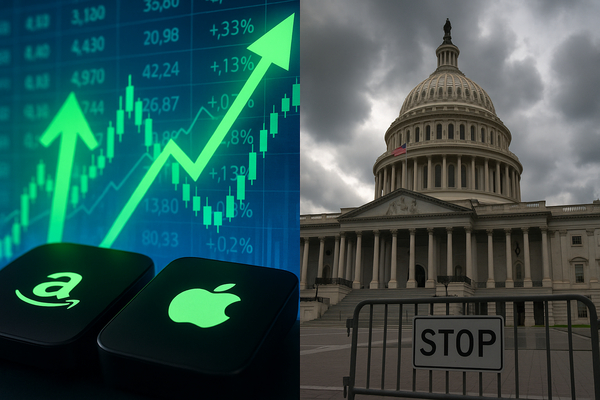
Big Tech Beats and a Shutdown Standoff. Amazon (NASDAQ:AMZN) and Apple (NASDAQ:AAPL) posted stronger-than-expected results that are reshaping market sentiment right now. At the same time, Senate Republicans rejected Donald Trump’s push to kill the filibuster and the government shutdown is tightening, weighing on consumer-facing sectors this week. In the short term, earnings are driving rallies and volatility. Over the long term, AI-driven cloud demand and hardware cycles are accelerating capital spending and supply-chain realignment. Globally, U.S. tech strength is lifting European and Asian markets. Locally, shutdown effects on SNAP, ACA enrollment and federal services add near-term economic stress. Compared with past earnings weeks, today’s combo of policy risk and big-tech upside is unusually concentrated and time-sensitive.
Markets: earnings splash meets political risk
Big tech reports set the tone for U.S. equities. Amazon (NASDAQ:AMZN) reported robust cloud growth and an EPS beat, with AWS revenue running ahead of expectations. Apple (NASDAQ:AAPL) delivered record EPS and a strong services performance. Investors reacted quickly. Major indices rallied on strong tech numbers, while narrower pockets of stress surfaced in sectors tied to federal spending and consumer support.
However, the political calendar tightened late in the week. Senate GOP leaders — including Majority Leader John Thune — publicly ruled out ending the filibuster to force a shutdown solution. That stance reduces the chance of a quick legislative fix and raises near-term uncertainty for programs that depend on stopgap funding.
Shutdown urgency: who feels the pain tomorrow
The shutdown’s immediate effects are acute. About 42 million Americans receive Supplemental Nutrition Assistance Program benefits. Those benefits are federally funded and state-administered. Many state programs report funds running dry for November.
Health coverage is also at risk: 22 million people receive Affordable Care Act subsidies, and open enrollment starts now. Premiums are set to rise sharply, with industry estimates pointing to substantial increases that will affect pocketbooks this winter.
Federal workers remain furloughed or unpaid. Airlines and transportation services are already reporting higher delays as contract staffing and air-traffic resources tighten. American Airlines (NASDAQ:AAL) and other carriers note operational pressure as the shutdown stretches on; travel disruptions tie directly to revenues and schedules this holiday season.
Sectors and stock implications: cloud, chips, energy and consumer flow
AI and cloud are driving the most visible winners. AWS strength helped Amazon’s shares surge. Cloud deals are accelerating infrastructure demand. That lifts chip and data-center equipment names and also bolsters firms providing power and cooling solutions.
Bloom Energy (NYSE:BE) and other energy-infrastructure players have seen attention because data centers require resilient power. Bloom Energy’s recent AI-related partnerships and sizable financing moves illustrate how energy and IT capex are linking up this cycle.
Consumer-sensitive names are tougher to read. Retailers that depend on lower-income discretionary spend may see pressure as SNAP benefits and ACA subsidies face disruption. Auto and parts retailers, like Advance Auto Parts (NYSE:AAP), reported mixed results this quarter; consumer strength in higher-income households is not fully offsetting stresses lower down the income scale.
Airlines and travel businesses face a direct, immediate hit. Flight delays and staffing problems ripple through Revenue Passenger Miles and ancillary revenues. Companies that disclosed operational headaches this quarter flagged timing risk around holiday travel.
Global angle and historical context
U.S. tech earnings have a global footprint. Strong iPhone demand and services growth at Apple (NASDAQ:AAPL) reverberate through Asia supply chains. Cloud demand boosts equipment orders in Europe and Asia. Emerging markets benefit where cloud infrastructure pipelines accelerate, but they remain vulnerable to U.S. consumer weakness if the shutdown deepens.
Historically, markets have punished prolonged U.S. shutdowns. Past episodes show short-lived market dips followed by recovery when fiscal disruptions end quickly. The difference today is that corporate results are skewing in opposite directions: large-cap tech is powering market gains while politically sensitive, consumer-exposed firms face pressure. That divergence can create concentrated, sector-level volatility rather than a uniform market move.
What to watch next (events, data points, legal moves)
Watch the Senate schedule and any bipartisan negotiations for stopgap spending. A near-term judicial order or administrative contingency funding from USDA could blunt the SNAP cliff for November but not fully restore program stability.
Monitor open-enrollment filings and insurer guidance on ACA premium changes. Those numbers will shape consumer budgets and health sector revenue flows. For travel and logistics, track operational updates from major carriers and union statements about staffing and safety.
On the corporate calendar, upcoming earnings and management commentary on AI, cloud capacity, and capital spending will matter. Firms that link direct revenue growth to AI and cloud contracts tend to move market sentiment more than cyclical players in the current environment.
Bottom line: concurrent drivers, different time horizons
Two forces are acting at once. Corporate momentum from Amazon (NASDAQ:AMZN) and Apple (NASDAQ:AAPL) is driving risk-on sentiment in the short run. Political stalemate over a shutdown and the filibuster is creating a persistent near-term drag on consumer-facing sectors and government services.
For markets, that means increased dispersion. Expect winners tied to AI, cloud and data centers to remain focal points for capital allocation. Expect pockets of pressure in travel, consumer staples reliant on low-income spending, and healthcare programs supported by temporary federal funding. The timing of resolution in Washington will determine how quickly those pockets recover.
This report is informational. It summarizes recent corporate reports and political developments that matter to markets today. It does not provide investment advice or recommendations.












